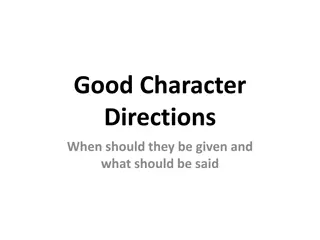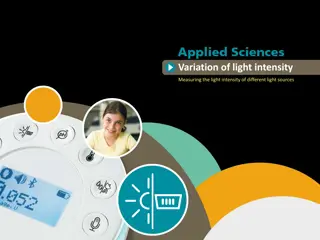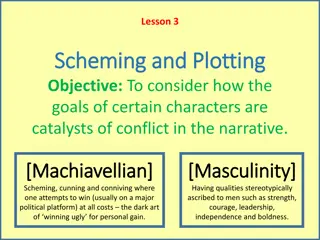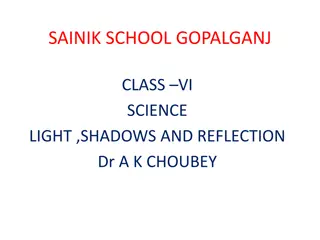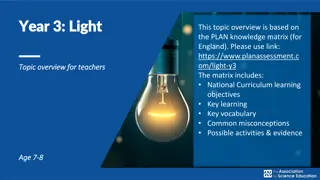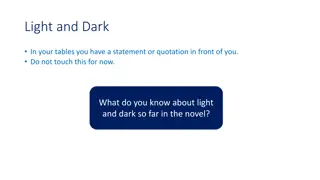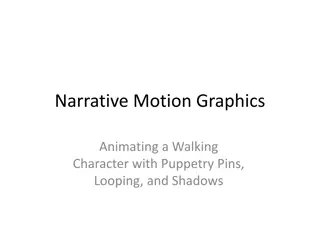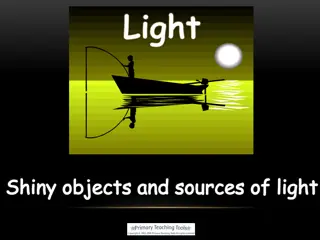Dark Setting and Character Dynamics in "All the Light We Cannot See
The setting of Zollverein in "All the Light We Cannot See" reflects a stark contrast between life and death, impacting the childhood of characters like Werner and Jutta. The dark imagery and ominous tone created by Anthony Doerr reveal the characters' struggles amidst a grim environment, highlighting the themes of escape and survival. Through detailed descriptions of the setting and character interactions, the novel explores the impact of surroundings on individual growth and resilience.
Download Presentation

Please find below an Image/Link to download the presentation.
The content on the website is provided AS IS for your information and personal use only. It may not be sold, licensed, or shared on other websites without obtaining consent from the author. Download presentation by click this link. If you encounter any issues during the download, it is possible that the publisher has removed the file from their server.
E N D
Presentation Transcript
All the Light Warm-ups by Steffani Packer
Characterization Identify and describe what specific details reveal about a character. What do the following details reveal about Werner and Jutta? What is Doerr emphasizing about them? And as night falls, Werner pulls little Jutta wordlessly back through the close-set neighborhoods of Zollverein, two snowy-haired children in a bottomland of soot, bearing their paltry treasures to Viktoria-strasse 3. . . (26).
Setting Explain the function of setting in a narrative. What do you know about Zollverein--the mines and the Children s House? How does the setting affect Werner s childhood? What function does this setting serve in the novel? It s steel country, anthracite country, a place full of holes. Smokestacks fume and locomotives trundle back and forth on elevated conduits and leafless trees stand atop slag heaps like skeleton hands shoved up from the underworld (24). All around them, the figures of second-shift workers shuffle into warehouses while first-shift workers shuffle home, hunched, hungry, blue-nosed, their faces like black skulls beneath their helmets. Hello, Werner will chirp, good afternoon, but the miners usually hobble past without replying, perhaps without even seeing them, their eyes on the muck . . . (25).
LAS paragraph The narrator s hopeless description of Zollverein, in Anthony Doerr s All the Light We Cannot See, suggests that this is a place one never escapes. Images of skeleton hands shoving up from the underworld and the black skulls of the miners convey feelings of death and devastation. These dark images establish almost a hellish tone, depicting fear that the hands coming from the underworld might snatch and drag a person below. Trees, which typically symbolize life and growth, stand leafless-- already dead or dying as the miners shuffle zombie-like to their homes. Clearly, the narrator demonstrates Werner s separation from this environment as he cheerfully chirps greetings at the men who only ignore him. This juxtaposition of a happy, snowy-haired boy surrounded by this dark setting illuminate the need for Werner to escape before he is entirely trapped. As a child, he has been able to maintain life and hope, but, once an adult, the mines wait hungrily for him.
CC&E The narrator s hopeless description of Zollverein, in Anthony Doerr s All the Light We Cannot See (CONTEXT), suggests that this is a place one never escapes. Images of skeleton hands shoving up from the underworld and the black skulls of the miners (EVIDENCE) convey feelings of death and devastation (COMMENTARY). These dark images establish almost a hellish tone, depicting fear that the hands coming from the underworld might snatch and drag a person below (COMMENTARY). Trees, which typically symbolize life and growth, stand leafless--already dead or dying as the miners shuffle zombie-like to their homes (EVIDENCE). Clearly, the narrator demonstrates Werner s separation from his environment (COMMENTARY) as he cheerfully chirps greetings at the men who only ignore him (EVIDENCE). This juxtaposition of a happy, snowy-haired boy surrounded by this dark setting illuminate the need for Werner to escape before he is entirely trapped (COMMENTARY). As a child, he has been able to maintain life and hope, but, once an adult, the mines wait hungrily for him (COMMENTARY).
Literary Elements FIG 6:E Identify and explain the function of a poetic/literary element in a text Which element do you see Doerr using here and what purpose does it serve? Above him, kneeling on his bunk, Frederick peers out the open window through a pair of antique field glasses and makes a record on the bed rail of birds he has sighted. One notch under red-necked grebe. Six notches under thrush nightingale. Out on the grounds, a group of ten year olds is carrying torches and swastika flags toward the river. The procession pauses, and a gust of wind tears at the torch flames. Then they march on, their song swirling up through the window like a bright pulsing cloud (140).
Literary Elements FIG 6:E Identify and explain the function of a poetic/literary element in a text How does Doerr s use of syntax connect to the meaning of the following paragraph? Roll call. Breakfast. Phrenology, rifle training, drills. Black- haired Ernst leaves the school five days after he is chosen as the weakest in Bastian s exercise. Two others leave the following week. Sixty becomes fifty-seven (183).
Literary Elements FIG 6:E Identify and explain the function of a poetic/literary element in a text Analyze the effect of Doerr s diction and syntax in the following paragraph. Everything becomes soaked in a hideous and wondrous slowness. Rodel rears back and strikes. This time he catches Frederick on the jaw. Werner forces his mind to keep sending up images of home: the laundry; Frau Elena s overworked pink fingers; dogs in the alleys; steam blowing from the stacks-- every part of him wants to scream: is this not wrong? But here it is right (194).
Characterization Skill: CHR 1.D: Describe how textual details reveal nuances and complexities in characters relationships with one another. Read the paragraph about Jutta on page 263, 3rd-4th paragraph. How are Werner s feelings about Jutta complex?
Prove It: (in your notebooks) (Prove or disprove the following with evidence from the text.) Werner is living in accordance with Herr Seidler s view of history: You know the greatest lesson of history? It s that history is whatever the victors say it is. That s the lesson. Whoever wins, that s who decides the history. We act in our own self-interest. Of course we do. Name me a person or a nation who does not. The trick is figuring out where your interests are (84).
Setting SET 2.C Describe the relationship between a character and a setting. This chapter describes Werner, Volkheimer, and Bernd s location of being trapped. Why did Doerr create this setting for this experience? First a corsair s cellar, built to safeguard gold, weapons, an eccentric s beekeeping equipment. Then a wine cellar. Then a handyman s nook. Atelier de reparation, thinks Werner, a chamber in which to make reparations. As appropriate a place as any. Certainly there would be people in the world who believe these three have reparations to make (205).
Structure and Narration STR 3.B: Explain the function of a particular sequence of events in a plot. NAR 4.B: Identify and explain the function of point of view in a narrative. Consider the structure of All the Light We Cannot See and its function in the novel. What does Doerr accomplish by structuring and narrating it this way? Non-chronological--the novel begins in 1944 at the climax of the story, then goes back 10 years, jumps back and forth again. Narration and Point of View is told through third person omniscient, the perspectives of most characters are known on both sides of the war. This perspective allows Doerr to reveal thoughts and feelings of people on opposite sides of the war, suggesting the humanness of each nation and their people, regardless of which side they were on.
Doerrs Answer: What made you decide not to tell the story chronologically? WWII is something contemporary readers already know a lot about. If our schools are doing their jobs, they know about the invasion of Normandy, the Hitler Youth, the Holocaust, and some of the horrors of the Eastern Front. So most readers already feel and intuit what s coming in this novel, at least in terms of the larger historical movement. They know the Germans will be driven out of Saint-Malo eventually, and they ll presume (correctly) that it will cost a lot of human lives to do so.I wanted to acknowledge that foreknowledge as soon as the book started. So I begin the story in 1944, before backtracking into Werner s and Marie s childhoods, in order to say to a reader: we all know what s coming. In a sense I tried to hang those American bombs, suspended, over the next three or four hundred pages of narrative.









